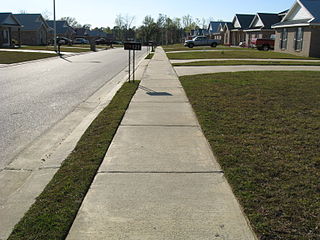
In the United States and Canada, redlining is the systematic denial of various services to residents of specific, often racially associated, neighborhoods or communities, either directly or through the selective raising of prices. While the best known examples of redlining have involved denial of financial services such as banking or insurance, other services such as health care or even supermarkets have been denied to residents. In the case of retail businesses like supermarkets, purposely locating stores impractically far away from targeted residents results in a redlining effect. Reverse redlining occurs when a lender or insurer targets particular neighborhoods that are predominantly nonwhite, not to deny residents loans or insurance, but rather to charge them more than in a non-redlined neighborhood where there is more competition.

The United States Department of Agriculture (USDA), also known as the Agriculture Department, is the U.S. federal executive department responsible for developing and executing federal laws related to farming, forestry, rural economic development, and food. It aims to meet the needs of farmers and ranchers, promote agricultural trade and production, work to assure food safety, protect natural resources, foster rural communities and end hunger in the United States and internationally.

The United States Department of Housing and Urban Development (HUD) is a Cabinet department in the Executive branch of the United States federal government. Although its beginnings were in the House and Home Financing Agency, it was founded as a Cabinet department in 1965, as part of the "Great Society" program of President Lyndon Johnson, to develop and execute policies on housing and metropolises.

Urban renewal is a program of land redevelopment often used to address urban decay in cities. Urban renewal is the clearing out of blighted areas in inner cities to clear out slums and create opportunities for higher class housing, businesses, and more.

Subdivision is the act of dividing land into pieces that are easier to sell or otherwise develop, usually via a plat. The former single piece as a whole is then known in the United States as a subdivision. If it is used for housing it is typically known as a housing subdivision or housing development, although some developers tend to call these areas communities.
Black Economic Empowerment (BEE) is a racially selective programme launched by the South African government to redress the inequalities of Apartheid by giving black South African citizens economic privileges that are not available to Whites. It is a form of Affirmative action. Although race is the overriding factor, it includes measures such as Employment Preference, skills development, ownership, management, socioeconomic development, and preferential procurement. By 2015 around R350 billion worth BEE deals had been done by the top 100 companies on the JSE with an additional R50 billion by private South African companies indicating that 10 percent of South Africa's GDP had been transferred to 20 percent of the population in the 15 years since 2000.
Town and country planning in the United Kingdom is the part of English land law which concerns land use planning. Its goal is to ensure sustainable economic development and a better environment. Each country of the United Kingdom has its own planning system that is responsible for town and country planning devolved to the Northern Ireland Assembly, the Scottish Parliament and the Welsh Assembly.
The Black Consciousness Movement (BCM) was a grassroots anti-Apartheid activist movement that emerged in South Africa in the mid-1960s out of the political vacuum created by the jailing and banning of the African National Congress and Pan Africanist Congress leadership after the Sharpeville Massacre in 1960. The BCM represented a social movement for political consciousness.
[Black Consciousness'] origins were deeply rooted in Christianity. In 1966, the Anglican Church under the incumbent, Archbishop Robert Selby Taylor, convened a meeting which later on led to the foundation of the University Christian Movement (UCM). This was to become the vehicle for Black Consciousness.

Aranda is a suburb in the district of Belconnen, in the Australian capital city of Canberra. Located at the western foot of Black Mountain and bounded on two sides by nature park, the suburb is characterised by its bush setting. During the planning and development of the suburb, a large proportion of large native trees – predominantly eucalypts – were left in place.
Racial steering refers to the practice in which real estate brokers guide prospective home buyers towards or away from certain neighborhoods based on their race. The term is used in the context of de facto residential segregation in the United States, and is often divided into two broad classes of conduct:
- Advising customers to purchase homes in particular neighborhoods on the basis of race
- Failing, on the basis of race, to show, or to inform buyers of homes that meet their specifications.

Racial segregation in the United States, as a general term, refers to the segregation of facilities, services, and opportunities such as housing, medical care, education, employment, and transportation in the United States along racial lines. The term mainly refers to the legally or socially enforced separation of African Americans from whites, but is also used in regards to the separation of other ethnic minorities from majority mainstream communities. While mainly referring to the physical separation and provision of separate facilities, it can also refer to other manifestations such as the separation of roles within an institution. Notably, in the United States Armed Forces up until the 1950s, black units were typically separated from white units but were nevertheless still led by white officers.
The system of racial segregation in South Africa known as apartheid was implemented and enforced by many acts and other laws. This legislation served to institutionalise racial discrimination and the dominance by white people over people of other races. While the bulk of this legislation was enacted after the election of the National Party government in 1948, it was preceded by discriminatory legislation enacted under earlier British and Afrikaner governments. Apartheid is distinguished from segregation in other countries by the systematic way in which it was formalised in law.
Mortgage discrimination or mortgage lending discrimination is the practice of banks, governments or other lending institutions denying loans to one or more groups of people primarily on the basis of race, ethnic origin, sex or religion.

The Laguna Lake Development Authority (LLDA), one of the attached agencies of the Department of Environment and Natural Resources (DENR), is responsible for the preservation, development, and sustainability of the Laguna de Bay and its 21 major tributary rivers.

Housing segregation is the practice of denying African American or other minority groups equal access to housing through the process of misinformation, denial of realty and financing services, and racial steering. Housing policy in the United States has influenced housing segregation trends throughout history. Key legislation include the National Housing Act of 1934, the GI Bill, and the Fair Housing Act. Factors such as socioeconomic status, spatial assimilation, and immigration contribute to perpetuating housing segregation. The effects of housing segregation include relocation, unequal living standards, and poverty. However, there have been initiatives to combat housing segregation, such as the Section 8 housing program.

Subsidized housing in the United States is administered by federal, state and local agencies to provide subsidized rental assistance for low-income households. Public housing is priced much below the market rate, allowing people to live in more convenient locations rather than move away from the city in search of lower rents. In most federally-funded rental assistance programs, the tenants' monthly rent is set at 30% of their household income. Now increasingly provided in a variety of settings and formats, originally public housing in the U.S. consisted primarily of one or more concentrated blocks of low-rise and/or high-rise apartment buildings. These complexes are operated by state and local housing authorities which are authorized and funded by the United States Department of Housing and Urban Development (HUD). More than 1.2 million households currently live in public housing of some type. Subsidized apartment buildings, often referred to as housing projects, have a complicated and often notorious history in the United States. While the first decades of projects were built with higher construction standards and a broader range of incomes and same applicants, over time, public housing increasingly became the housing of last resort in many cities. Several reasons have been cited for this negative trend including the failure of Congress to provide sufficient funding, a lowering of standards for occupancy, and mismanagement at the local level. Furthermore, housing projects have also been seen to greatly increase concentrated poverty in a community, leading to several negative externalities. Crime, drug usage, and educational under-performance are all widely associated with housing projects, particularly in urban areas.

The Housing and Urban Development Act of 1968, Pub.L. 90–448, 82 Stat. 476, enacted August 1, 1968, was passed during the Lyndon B. Johnson Administration. The act came on the heels of major riots across cities throughout the U.S. in 1967, the assassination of Civil Rights Leader Martin Luther King Jr. in April 1968, and the publication of the report of the Kerner Commission, which recommended major expansions in public funding and support of urban areas. President Lyndon B. Johnson referred to the legislation as one of the most significant laws ever passed in the U.S., due to its scale and ambition. The act's declared intention was constructing or rehabilitating 26 million housing units, 6 million of these for low- and moderate-income families, over the next 10 years.

The Bay State Banner is an independent newspaper primarily geared toward the readership interests of the African-American community in Boston, Massachusetts. The Bay State Banner was founded in 1965 by Melvin B. Miller who remains the chief editor and publisher. In 2015, the publication celebrated its 50th anniversary serving the region's minority-oriented neighborhoods.













